You’re ready for a fresh start. You want to implement the methodology from Chapter 5 and (finally!) focus on the interactions in your team. You’re eager to enable a culture of feedback, continuous improvement and high performance.
The process, all together, looks like this:
- Recommit to enabling honest, helpful feedback
- Separate compensation from reviews
- Enable regular, peer-to-peer feedback invitations
- Give training + guidance
- Build trust + safety with belonging cues
- Initiate public self-reflection
If you’re thinking, “Hmmm, unfortunately I don’t have the organizational buy-in or autonomy to replace our existing process 100% yet” — then you’ll want to read Chapter 7: How to implement aspects of our KYT methodology.
If you’re thinking, “Yes, yes, I’m ready to try something fresh” — to fully implement our principles into action at your own organization, here are the steps in detail…
(Full caveat, implementing parts of our methodology will not be as effective as implementing all of it as described here. But I hope Chapter 7 may give you a foothold for further change, as your organization welcomes it.)
Step 1: Recommit to the interaction 🤝
Your renewed commitment is not to a tool, not to a process — but a commitment to better interactions between team members. This means you will need to ensure that your performance review process is about performance feedback, rather than succession planning or compensation. In short, it’s about growth, not judgment. You can build in a succession planning model and compensation model and promotion on top of this. (I detail this in Step 2.) But the interaction is the most important thing to get right, first.
To share this commitment with your organization…
Send a written note + discuss this renewed commitment to continual feedback in your next all-team meeting. Use your written announcement and all-team meeting to build trust and get people feeling comfortable being vulnerable to share honest feedback. You’re aiming to set a new tone, a new precedent, that what matters is how everyone on the team can be helping each other improve, more than anything else.
Here’s an example of an email you could send to your whole organization to share this renewed commitment to feedback…
Hey team —
I know I’ve talked a lot about the importance of honest feedback in a team, but I haven’t always walked the talk. I find myself not always giving feedback as often — nor as well-delivered — as I’d like. And, I haven’t always welcomed honest feedback as explicitly as I could.
Personally, I want to change. I know you’re counting on me to give you developmental feedback to help you each grow in your careers. And, likewise, I am heavily relying on you to give me honest feedback so I can become a better leader.
Simply put: We won’t thrive — as a team, and as individuals — if we’re not able to commit to giving truly honest feedback to one another so we can improve and level-up as a team.
As a result, I’m excited to try a new feature from KYT called Performance Feedback that is focused on creating a culture of feedback and replacing the need for any traditional performance reviews.
We’ll be starting on [DAY/TIME], so would love to know what you think + learn as we use it…
I’ll share more in the coming days — but beyond just an app, I am personally excited to recommit to giving and receiving feedback with each of you.
— YOUR NAME
Step 2: Separate compensation discussion/system from performance feedback 💸
You may already separate compensation discussions from performance feedback in your organization — which is fantastic! If so, you can skip to Step 3.
For those of you in organizations where compensation and performance feedback are still coupled, this is often the most daunting step. It can feel nebulous as to how an organization can separate compensation from performance feedback when historically the two have been so closely tied…
However, the reality is that this can be a relatively uncomplicated change to make as long as you:
- Set up a distinct channel and process for compensation conversations
- Clearly communicate the “why” and “how” around the change
Set up a distinct channel + process. You must make a clear decision in your organization to separate compensation discussions from performance feedback. This means carving out a distinct channel for discussing compensation. You can execute this channel in a myriad of ways, but the key thing with the first iteration is simply ensuring it is a separate discussion.
As reference, here are some specific examples for how other organizations separate compensation discussions from performance feedback…
- Two conversations: At Gap, compensation conversations are held once a year, and managers are given a detailed model to match compensation with performance. Similarly, at Google, the two conversations are separated by a month: In November, a conversation about performance is held, and in December, a conversation about compensation and role changes is held.
- Career path focus: At Spotify, a career path is made transparent to team members. Promotions are determined “when you and your manager agree that you are consistently operating at the next step. Specifically, promotions do not need to be tied to the annual salary review cycle.”
- Salary calculator: At Buffer, a transparent salary formula is used to calculate compensation.
- Top of market pay: At Netflix, a completely different approach is taken: Compensation is purely dictated by the market rate, with Netflix paying its staff always top of market instead of allocating bonuses.
Please note that you could absolutely combine approaches (e.g., two conversations and have a salary calculator) — and there is no one-size fits all. You should choose and pilot a path based on your own organizational context, dynamics, and goals.
After you create a separate channel for discussing compensation, then you’ll need to communicate this change…
Clearly communicate the “why” and “how” around the change. At the end of the day, you’re wanting to separate compensation from performance feedback to enable a more positive work culture. Make sure to communicate this — the overall aim — of this change, and then detail how this change will be executed.
Here’s an example of how you could communicate having a separate compensation discussion to your team…
Hey team —
Here at [ORGANIZATION NAME], we’re committed to creating a culture of feedback + continuous improvement.
However, we noticed that in the past, when we lumped compensation conversations with performance feedback conversations, it made things very difficult for us to actually focus on growth and improvement.
We’ve since realized that there’s a more thoughtful, intentional way to discuss compensation — and separately share developmental feedback with each other. As a result, we’d love to make the conversation around compensation separate from the performance feedback we give each other.
To do this, we’ll be holding a “compensation conversation” once a year, as a one-on-one meeting between you and your direct manager. This meeting will occur every [INSERT MONTH] and will be scheduled via KYT’s One-on-Ones tool. During it, we’ll review how compensation is determined at [ORG NAME] and discuss what changes if any are to be made.
We’ll start these compensation conversations this year. Since this is the first time we’re doing this, I’d love any and all feedback on what would make those conversations even more helpful and transparent — and what the experience feels like.
Look forward to hearing what you think. Our hope is that this enables us to have a culture of growth and improvement.
— YOUR NAME
If you’re wondering what tooling could help you separate these conversations, you can use KYT One-on-Ones tool to hold a separate compensation discussion every year or twice a year, and create a template for the conversation as well. Our One-on-Ones tool will automatically schedule the 1:1 meetings for you and insert whatever template you’d like to have for the compensation conversation.
Note: Of course, you do not have to use our KYT One-on-Ones tool tool in order to send this message + hold a separate compensation discussion, so feel free to omit that part of the messaging if that fits best for your team.
Step 3: Enable regular, peer-to-peer feedback invitations 📬
Now we’re ready to get to the heart of our performance review alternative process: Peer-to-peer feedback invitations.
Remember that feedback is more likely to internalize and welcome feedback when you’ve invited it vs. when it’s imposed on you. Think of it like a party invitation: When someone invites you to a party, you’re much more likely to go, rather than show up unannounced. Invitations for feedback have the same effect.
Because of this, your performance review alternative should focus on inviting feedback. In other words: Instead of issuing a set of questions people need to answer, you’ll want to nudge your team members to invite feedback from their peers.
You can invite feedback via one-off requests in an email, Slack or Microsoft Teams. Or, you can schedule a one-on-one meeting to carve out dedicated time to invite feedback. As a manager, you’ll also want to encourage your direct reports to also invite feedback from you and their peers as well. All together, everyone on your team should be inviting feedback (and giving feedback) at least once a week.
Here’s an example of what a feedback invitation could say…
🚦 Do you have any suggestions for what I should "Start, Stop, or Continue"? Please share your feedback directly with the person via writing, or in a 1:1 meeting.
What’s one thing recently that you’ve noticed that I could tweak, adjust, or improve upon? Please share your feedback directly with the person via writing, or in a 1:1 meeting.
How well am I helping you navigate uncertainty? Please share your feedback directly with the person via writing, or in a 1:1 meeting.
As you might imagine, remembering to initiate these feedback invitations can feel tedious and time consuming. This is one of the places where a software tool can be helpful in helping create the habit of inviting feedback so it feels more easeful. Our KYT Performance Feedback tool was in fact designed with this in mind.
Our alternative also suggests questions to your team members on what they should ask for feedback on and to whom. Here’s an example of what setting this up in KYT might look like:

Then, KYT automatically nudges your team and invites that feedback via email, Slack, or Microsoft Teams:
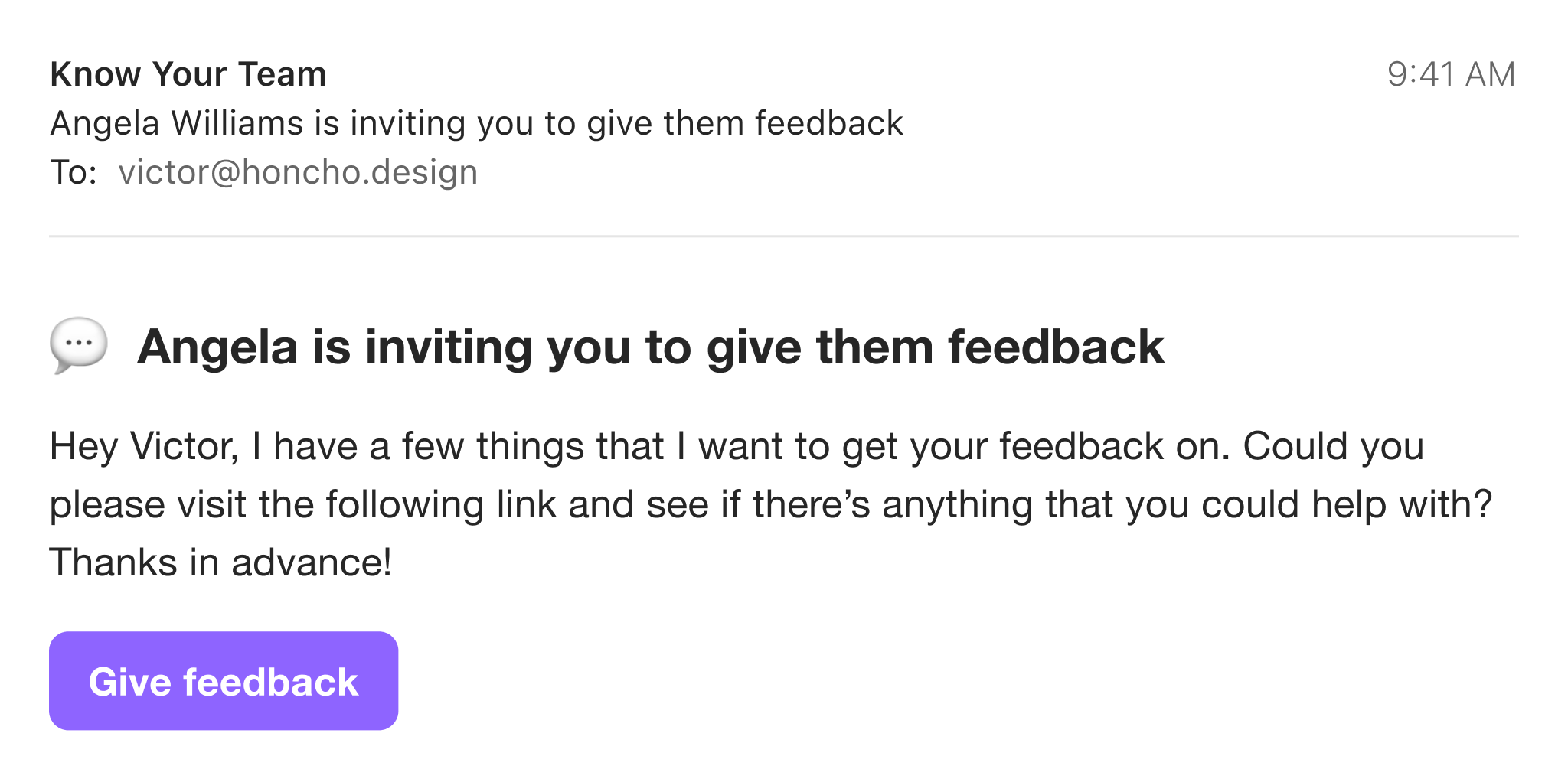
Note that these are soft, infrequent nudges happening once every two weeks, that integrate with whatever communication channel your team already is using (email, Slack, or Microsoft Teams). This way, you’re receiving unintrusive reminders — and you + your team don’t have to constantly remember if or when you’ve been giving helpful feedback.
Additionally, in our Performance Feedback tool, not only do we automate the invitations for you so you don’t have to remember to manually send each one, but we curate the specific questions, based on our research, to enable the best feedback possible.
Here’s an example:
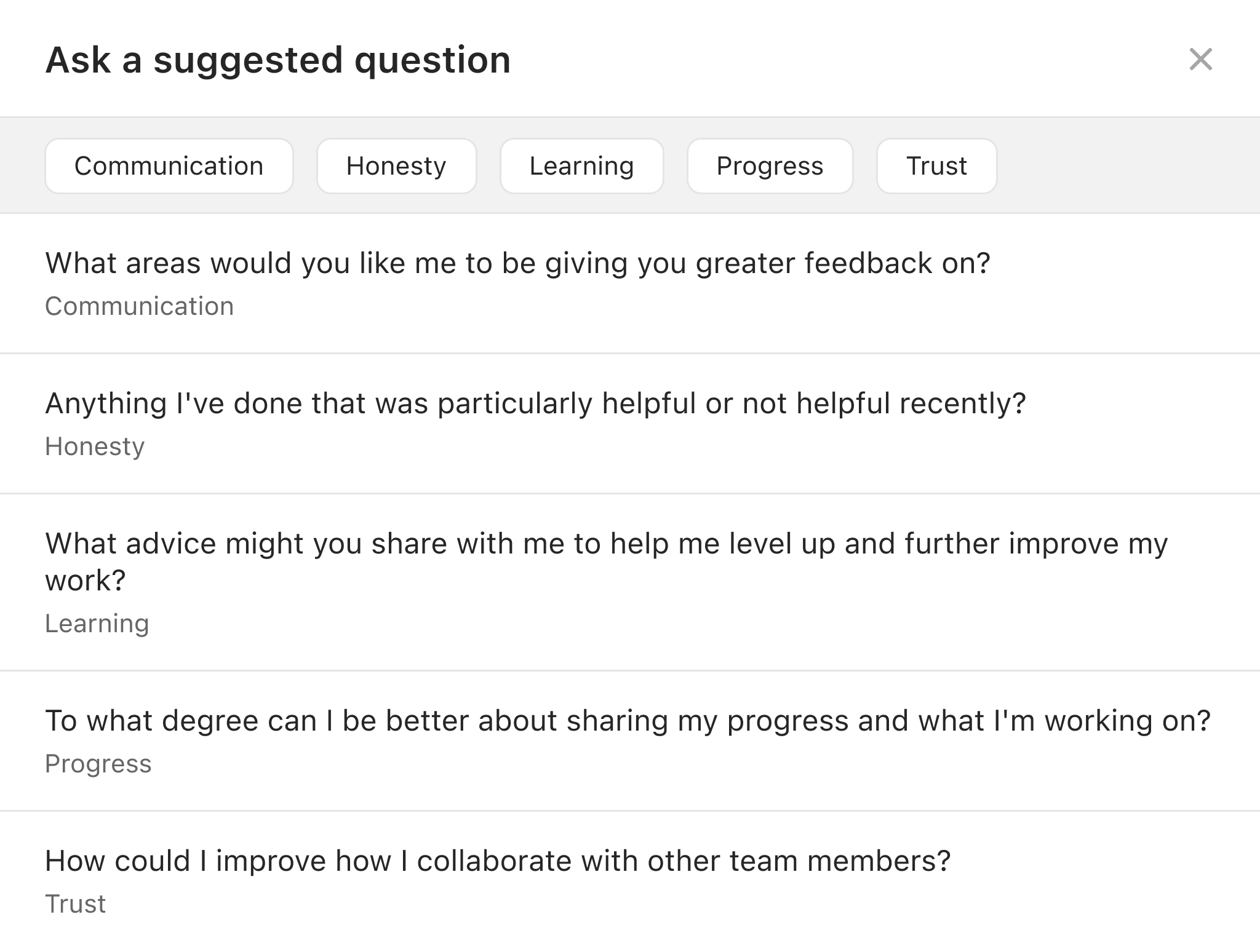
Curious how it might work for your team? Request a demo of our KYT Performance Feedback tool.
What about more sensitive feedback?
You may be thinking, “I could see this working for low-level feedback… But what if someone needs to give meatier, sensitive feedback? Can it be invited through the tool alone?” I hear you: You absolutely want to make space for more sensitive feedback to be brought up and talked about more deeply, one-on-one.
As a result, we recommend holding a performance-focused 1:1 meeting once a month, where you actively invite even deeper feedback and/or discuss what’s been shared in the Performance Feedback tool.
Here’s an example of the agenda for that monthly performance-focused 1:1 meeting…
Personal connection (~10 minutes)
- How is your energy level these days?
Performance feedback (~40 minutes)
- Based on feedback shared via the Performance Feedback tool, ____ was an improvement area for me. How do you think I’ve been progressing in that area?
- What feedback should we discuss further from the Performance Feedback tool?
- What about my management style can I improve?
- What feedback should we discuss further from the Performance Feedback tool?
- What about my management style can I improve?
- What aspect of my job do you think I can do better?
- Would you be open to me sharing some performance feedback and opportunities for growth for you?
- Do you mind me sharing a few small observations on what I think could be better?
Takeaways / next steps (~10 minutes)
You can use our KYT One-on-Ones tool + template to set-up this recurring performance-focused 1:1 meeting.
Alrighty, but what about when you have to give feedback. How can you help your team give feedback well so they can continually improve their performance?
You’ll want to read the next step…
Step 4: Give training + guidance on how to best give and receive feedback 🧠
Arguably the most important aspect of enabling your team to perform at the highest level is training your team on how to best give and receive feedback.
You can set up whatever processes, systems, and tools you’d like… But if there is no training + guidance on how to exactly give difficult feedback, then honest feedback isn’t going to happen in your team — and your team’s performance will stagnate.
As a result, we recommend utilizing some kind of feedback training resources to support your team so you can enable high performance.
What we’ve found best to work for feedback training is to give guidance to folks in-the-moment. That is, in-the-moment, when you need to give honest feedback to someone: What is the checklist, guide or resource that you can consult?
We built into KYT in-the-moment training and guidance as the answer to this question.
For example, in KYT, if you respond to a team member’s feedback invitation, as you go to write your feedback, there is an “Assistant” inline on the right-hand side of the screen that gives you a checklist and templates for how to best give feedback:
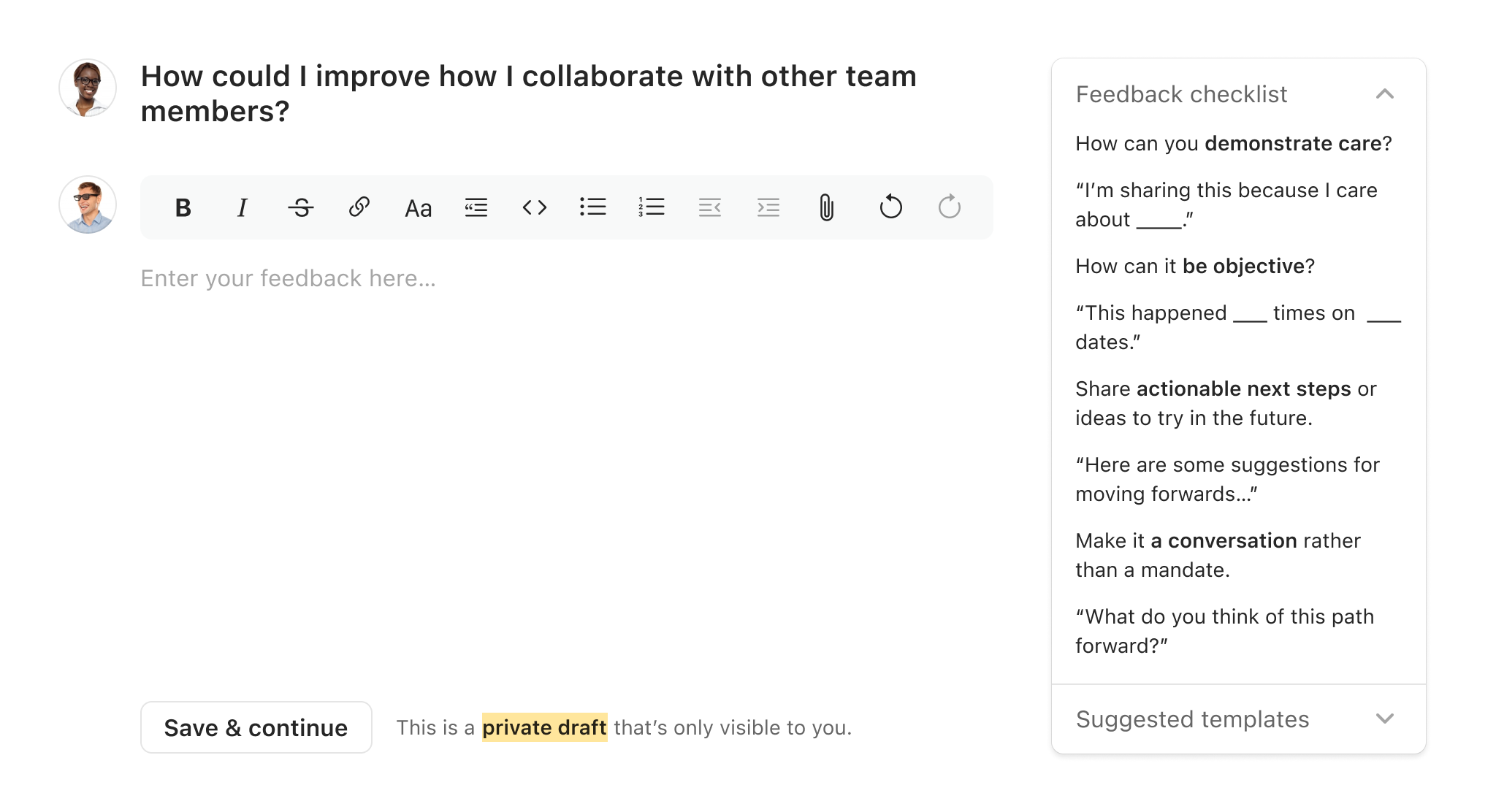
Additionally, when you receive feedback, yourself, you have the ability to have a “Receiving Feedback” checklist in-the-moment to remind yourself of what to keep in mind as you internalize the feedback:
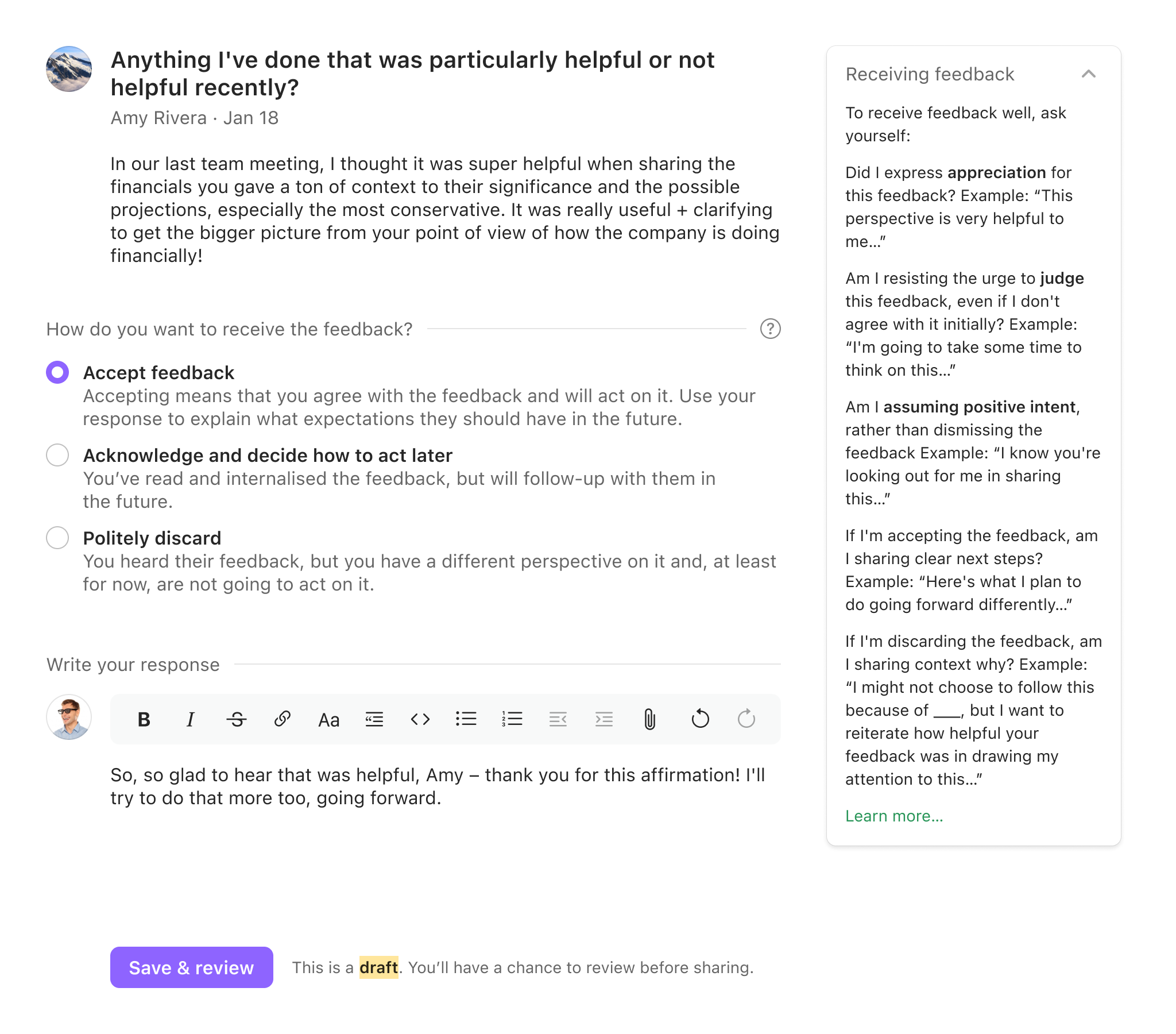
These are just some of the built in-app training, guides, and checklists you and your team can continually learn, in-the-moment, as you use the tool.
Want to see it in action? Try out the KYT Performance Feedback tool and see how the in-app training works.
Additionally, for more in-depth live training, you can partner with us here and dive into our Performance Conversation module. Over the past 8 years, we’ve trained more than 20,000 people around feedback, teamwork, and leadership skills, and have developed a specific set of on-demandtraining to help you implement our Performance Review Alternative methodology.
If you already have robust feedback training in your organization in place – that’s fantastic! Then, you have a solid foundation for creating a culture of feedback that engenders high performance in your team — bravo. 😊
Step 5: Build trust + safety with belonging cues 💙
To further a culture of feedback and continued improvement, as a leader, you must model the behavior you want to be true in your team. If you want your team to be embracing a mindset of honest feedback, continual improvement, and high performance, consider: What can you say and do to show that?
Here are a few ideas for building trust and safety for your team to feel comfortable giving each other performance feedback:
-
Gather once a quarter as a team to share what feedback has been most meaningful for each team member. To reinforce the idea that honest feedback is helpful for team performance, try holding an all-team meeting once a month or once a quarter where you ask each person to share feedback that was recently given to them that they found helpful. More than anything, this solidifies the “social norm” that honest feedback is helpful and uplifts the team’s performance.
- For example: “I’d love for us to go around and each take 1-2 minutes to share what was a piece of feedback you received recently that you found helpful, and why…”
-
Share the most helpful piece of feedback you personally received via the KYT Performance Feedback tool. During all-team meetings and/or in writing, share when someone gives you helpful feedback (with their permission, of course), and why you found the feedback so valuable. This demonstrates how feedback given is internalized on not landing on idle ears.
- For example: “I’m so grateful for [NAME] sharing a pointer with me on ____. It’s so massively helpful for me…”
- You can use our KYT Shout-outs tool to do this, as well.
-
Share what you personally would like to improve on. Describe a situation you wish you would’ve handled differently, or offer what your own goals are for becoming a better leader. This helps encourage others to give you feedback in those areas, as you’re showing how you’re open to it.
- For example: “Personally, in the upcoming quarter, I want to make sure I’m focused on _____ as a way for me to improve as a leader and best serve the team…”
-
Actively take action on feedback you receive. There is no better indicator that feedback was listened to when it’s acted on — even in a small way. Consider how quickly you’ve implemented helpful feedback, and let the person who gave you that feedback know. Doing so shows immediate impact and will encourage your entire team to continue giving similar feedback.
- For example: “[NAME] had a great idea shared via the KYT Performance Feedback tool that we’re going to implement. It’s…”
Note that our Performance Feedback tool automatically encourages these belonging cues to establish safety, once you start using it, as well.
Step 6: Initiate active, shared self-reflection 🌱
As discussed in Chapter 5, self-reflection is one of the most powerful means of improving team performance. Accordingly, you’ll want to encourage your team to write a self-reflection at least once a month about their own performance. Ideally, this is a self-reflection that they share with the rest of the team publicly, in the spirit of encouraging the rest of the team to similarly self-reflect on how they can improve.
In our Performance Review Alternative, we automatically incorporate active, shared self-reflection, so you don’t have to manually initiate it with your team. We also give you excellent self-reflection prompts so you and your team are not starting from scratch. Here is an example:
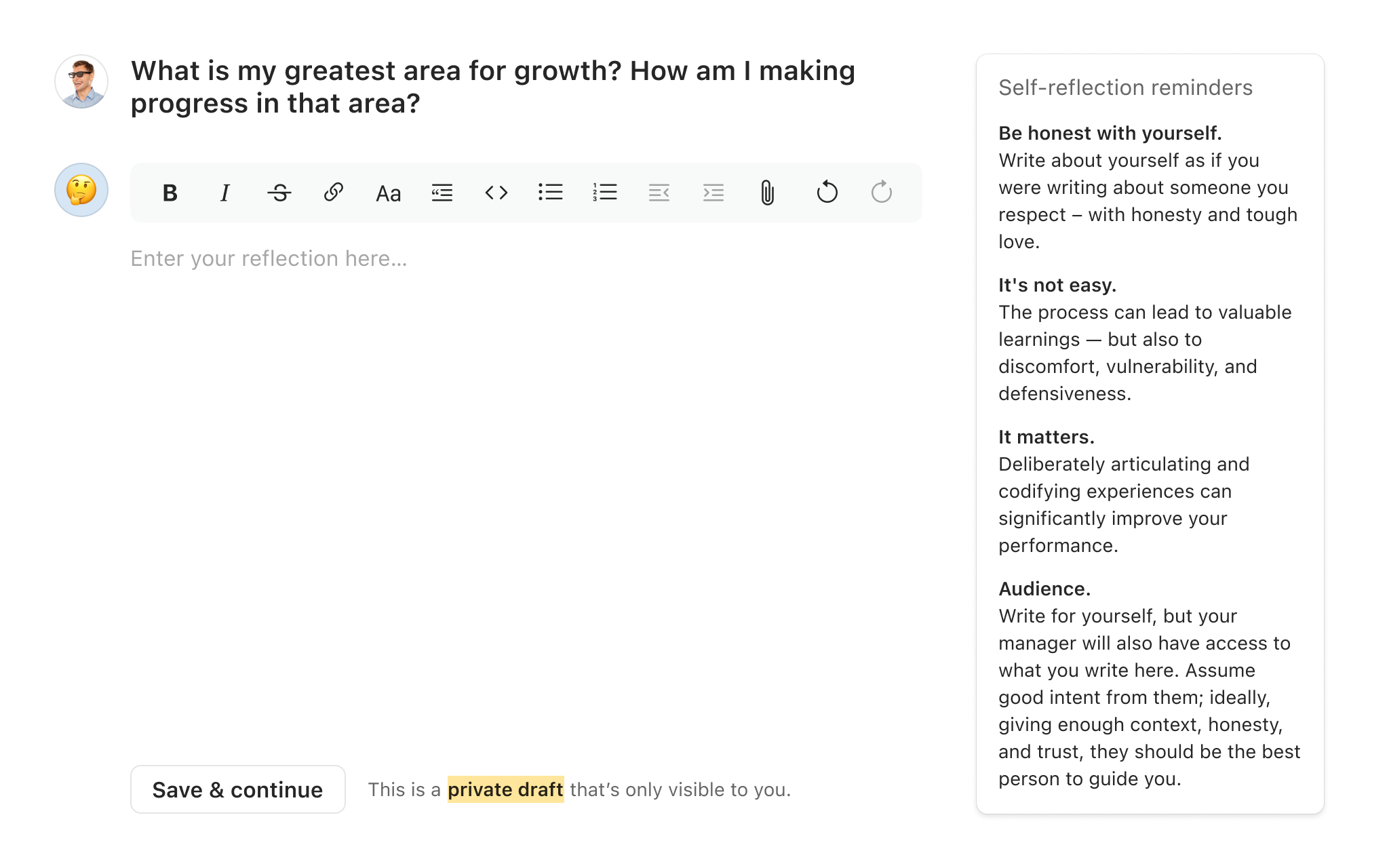
Your team is gently nudged once a month via your choice of email, Slack or Microsoft Teams, to complete a Self-Reflection and encouraged to share it with the rest of the team.
In KYT, we also give you excellent self-reflection prompts so you and your team are not starting from scratch. Alternatively, you could absolutely do this manually, if you’d like.
Here’s an example of prompt(s) you could use to encourage self-reflection in your team…
What area(s) of growth would you like to focus on?
Which organizational value(s) do you feel you’re best upholding? In what ways do you want to improve?
To what degree are you satisfied with how you spend your time?
Want to see how your team might use Self-Reflection? Try out the KYT Performance Feedback tool
The result: A culture of feedback + continual improvement
When using our performance review alternative, here’s what you can expect to start hearing from your team…
- “I would have never given this feedback without the help of KYT…”
- “This is so helpful for me to understand what I can be doing better…”
- “Oh wow, I had no idea that was something that I should improve on…”
In sum
Our KYT recommendation is to reorient the performance review to be centered on the one thing that makes a difference: The interaction.
The process, all together, looks like this:
- Recommit to enabling honest, helpful feedback
- Separate compensation from reviews
- Enable regular, peer-to-peer feedback invitations
- Give training + guidance
- Build trust + safety with belonging cues
- Initiate public self-reflection
If this all feels a bit manual — no worries. 👍 The most straightforward and easeful way to implement this methodology is to use Performance Feedback tool — Know Your Team’s alternative to performance reviews.
If you have an existing performance review system that cannot currently be replaced but only slightly adjusted, please read Chapter 7 on how to implement certain aspects of our methodology.